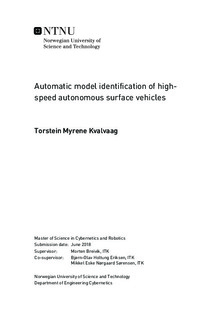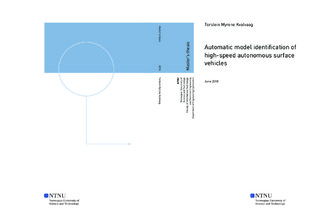| dc.contributor.advisor | Breivik, Morten | |
| dc.contributor.advisor | Eriksen, Bjørn-Olav Holtung | |
| dc.contributor.advisor | Sørensen, Mikkel Eske Nørgaard | |
| dc.contributor.author | Kvalvaag, Torstein Myrene | |
| dc.date.accessioned | 2018-08-31T14:02:35Z | |
| dc.date.available | 2018-08-31T14:02:35Z | |
| dc.date.created | 2018-06-11 | |
| dc.date.issued | 2018 | |
| dc.identifier | ntnudaim:18632 | |
| dc.identifier.uri | http://hdl.handle.net/11250/2560384 | |
| dc.description.abstract | This thesis investigates a method for identication of a non-first principle control-oriented model for autonomous surface vehicles (ASVs) suggested in [7]. The goal is to develop an automatic substitute for the identification procedure. The identification is divided into three steps: steady state identification (SSID), data extraction, and a parameter identification with linear regression. Automatic solutions are developed for each step, implemented, and tested in full-scale.
The identification procedure is based on analysis of data collected from experiments performed by executing input step sequences. To automate the experiments a method for online SSID in noisy processes suggested in [5] is adapted and applied. The method is based on the behavior of a ratio between two variance estimates and performs well given reasonable sea conditions.
Measurements of damping and inertia are extracted from each step response performed in the experiment. Damping is read directly from steady state behavior, while inertia is obtain by curve fitting the transient response. The curve fitting is solved using numerical optimization, more specifically through application of Broyden, Fletcher, Goldfarb, and Shanno's method (BFGS).
The measurements of damping and inertia are gathered in data sets and linear regression is applied to identifify models describing the data in each set. An automatic weighting scheme is formulated to be used in the regression, and ridge regression is applied for regularization.
The developed method is implemented as a real time system using the Robot Operating System (ROS). Then, full-scale experiments are performed using a surface vessel supplied by Maritime Robotics called Telemetron.
Results from the experiment emphasizes the need for better experiment design and strategies to combat the effects of the high signal-to-noise ratio present in some parts of the state space. Methods for identifying and repeating step responses heavily influenced by disturbances, and for detecting and removing outliers in the data sets are considered necessary if the method is to be used without human supervision. That being said, given that the vessel behaves within reason during the experiments the method represents a powerful and easily accessible modelling tool. | |
| dc.language | eng | |
| dc.publisher | NTNU | |
| dc.subject | Kybernetikk og robotikk, Navigasjon og fartøystyring | |
| dc.title | Automatic model identification of high-speed autonomous surface vehicles | |
| dc.type | Master thesis | |

